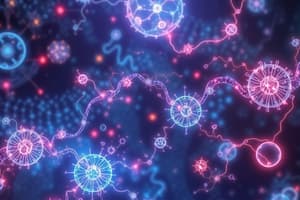Podcast
Questions and Answers
What is the primary function of metabolism in a cell?
What is the primary function of metabolism in a cell?
- To manage highly coordinated cellular activities using multi-enzyme systems. (correct)
- To facilitate cellular communication.
- To maintain structural integrity.
- To regulate gene expression.
Which of the following best describes autotrophs?
Which of the following best describes autotrophs?
- Organisms that obtain carbon from complex organic molecules.
- Organisms that use carbon dioxide from the atmosphere and are self-sustaining. (correct)
- Organisms that use solar energy.
- Organisms that are dependent on other organisms for nutrients
In the context of metabolism, what is the role of precursor molecules?
In the context of metabolism, what is the role of precursor molecules?
- They transport molecules across cell membranes.
- They serve as building blocks for larger molecules. (correct)
- They regulate enzyme activity.
- They catalyze metabolic reactions.
What is released during catabolism?
What is released during catabolism?
Which type of organisms obtain nutrients from the degradation of organic matter produced by autotrophs?
Which type of organisms obtain nutrients from the degradation of organic matter produced by autotrophs?
What is the role of nitrogen in living organisms?
What is the role of nitrogen in living organisms?
What process begins with sunlight and involves photosynthetic organisms and heterotrophic organisms?
What process begins with sunlight and involves photosynthetic organisms and heterotrophic organisms?
What is the term for the conversion of a precursor to a product through a series of linked reactions?
What is the term for the conversion of a precursor to a product through a series of linked reactions?
What must occur for a reaction to be spontaneous (i.e. proceed in the forward direction without external energy input)?
What must occur for a reaction to be spontaneous (i.e. proceed in the forward direction without external energy input)?
Which of the following reaction types involves atoms leaving as radicals?
Which of the following reaction types involves atoms leaving as radicals?
Which of the following helps stabilize carbanions?
Which of the following helps stabilize carbanions?
How does ATP participates in both catabolic and anabolic pathways?
How does ATP participates in both catabolic and anabolic pathways?
What is the general role of enzymes in metabolic reactions?
What is the general role of enzymes in metabolic reactions?
What type of biological process is linked to the exergonic breakdown of nucleoside triphosphates?
What type of biological process is linked to the exergonic breakdown of nucleoside triphosphates?
What is ΔG´° (delta G prime knot)?
What is ΔG´° (delta G prime knot)?
What is the role of the enzyme luciferase in bioluminescence?
What is the role of the enzyme luciferase in bioluminescence?
What is the significance of membrane being selectively impermeable to polar solutes.
What is the significance of membrane being selectively impermeable to polar solutes.
What is the major factor that drives the assembly and maintenance of biological membranes?
What is the major factor that drives the assembly and maintenance of biological membranes?
What is true about transmembrane proteins?
What is true about transmembrane proteins?
What property tends to be true for a helixes in the interior of a membrane?
What property tends to be true for a helixes in the interior of a membrane?
A researcher discovers a new transport protein. What characteristic would suggest that it functions as an active transporter rather than a passive transporter?
A researcher discovers a new transport protein. What characteristic would suggest that it functions as an active transporter rather than a passive transporter?
Which of the following is characteristic of transport via ion channels?
Which of the following is characteristic of transport via ion channels?
Which mechanism accounts for the rapid movement of glucose across the cell membrane?
Which mechanism accounts for the rapid movement of glucose across the cell membrane?
Which of the following processes is used to pump Ca2+ from the cytosol?
Which of the following processes is used to pump Ca2+ from the cytosol?
In the nitrogen cycle, what process converts atmospheric dinitrogen into ammonia?
In the nitrogen cycle, what process converts atmospheric dinitrogen into ammonia?
Which cellular component of the nitrogen cycle uses the enzyme nitrogenase?
Which cellular component of the nitrogen cycle uses the enzyme nitrogenase?
What direct purpose does ATP perform in the nitrogen cycle?
What direct purpose does ATP perform in the nitrogen cycle?
What role is attributed to amide nitrogen in Glutamine?
What role is attributed to amide nitrogen in Glutamine?
Which of the following is a notable intermediate in several pathways for the biosynthesis of amino acids?
Which of the following is a notable intermediate in several pathways for the biosynthesis of amino acids?
Which two conditions inhibit uridylylation and stimulates deuridylylation?
Which two conditions inhibit uridylylation and stimulates deuridylylation?
What is the function of the enzyme glutamine synthetase, as well as what conditions activate it?
What is the function of the enzyme glutamine synthetase, as well as what conditions activate it?
A cell is found to be synthesizing excessive amounts of glutamine. Which of the following regulatory mechanisms would MOST likely be activated to restore balance?
A cell is found to be synthesizing excessive amounts of glutamine. Which of the following regulatory mechanisms would MOST likely be activated to restore balance?
Which factor critically influences the equilibrium and spontaneity of biochemical reactions within a cell?
Which factor critically influences the equilibrium and spontaneity of biochemical reactions within a cell?
What is the role of the "positive-inside rule" in the context of membrane proteins?
What is the role of the "positive-inside rule" in the context of membrane proteins?
A researcher is studying a bacterium that thrives in high-salt environments and notices that its membrane contains unique lipids with increased amounts of branched fatty acids. How these changes affect to membrane dynamics?
A researcher is studying a bacterium that thrives in high-salt environments and notices that its membrane contains unique lipids with increased amounts of branched fatty acids. How these changes affect to membrane dynamics?
What aspect of the lipid asymmetry in the plasma membrane facilitates cell signaling and apoptosis?
What aspect of the lipid asymmetry in the plasma membrane facilitates cell signaling and apoptosis?
Which characteristic is associated with a P-type ATPase?
Which characteristic is associated with a P-type ATPase?
Flashcards
Metabolism
Metabolism
Highly coordinated cellular activity using multi-enzyme systems.
Autotrophs
Autotrophs
Photosynthetic organisms that use carbon dioxide from the atmosphere and are self-sustaining.
Heterotrophs
Heterotrophs
An organism acquiring carbon from environmental sources of organic molecules.
Catabolism
Catabolism
Signup and view all the flashcards
Anabolism
Anabolism
Signup and view all the flashcards
Km
Km
Signup and view all the flashcards
Bioenergetics
Bioenergetics
Signup and view all the flashcards
Gibbs Free Energy
Gibbs Free Energy
Signup and view all the flashcards
Enthalpy (H)
Enthalpy (H)
Signup and view all the flashcards
Entropy (S)
Entropy (S)
Signup and view all the flashcards
Cells & Equilibrium
Cells & Equilibrium
Signup and view all the flashcards
Standard Free Energy
Standard Free Energy
Signup and view all the flashcards
Negative ∆G'°
Negative ∆G'°
Signup and view all the flashcards
Actual Free Energy
Actual Free Energy
Signup and view all the flashcards
Enzymatic Reactions
Enzymatic Reactions
Signup and view all the flashcards
Nucleophiles
Nucleophiles
Signup and view all the flashcards
Electrophiles
Electrophiles
Signup and view all the flashcards
Carbonyl Group
Carbonyl Group
Signup and view all the flashcards
Integral Proteins
Integral Proteins
Signup and view all the flashcards
Micelles
Micelles
Signup and view all the flashcards
Bilayers
Bilayers
Signup and view all the flashcards
vesicles
vesicles
Signup and view all the flashcards
Membrane Impermeability
Membrane Impermeability
Signup and view all the flashcards
Fluid Membrane
Fluid Membrane
Signup and view all the flashcards
Group Transfer
Group Transfer
Signup and view all the flashcards
Phosphoryl Group Transfer
Phosphoryl Group Transfer
Signup and view all the flashcards
Biological Oxidation
Biological Oxidation
Signup and view all the flashcards
ATP Instability
ATP Instability
Signup and view all the flashcards
Transporters
Transporters
Signup and view all the flashcards
Passive Transporters
Passive Transporters
Signup and view all the flashcards
Passive Transporters
Passive Transporters
Signup and view all the flashcards
Chloride-Bicarbonate
Chloride-Bicarbonate
Signup and view all the flashcards
Passive Transport
Passive Transport
Signup and view all the flashcards
Aquaporins
Aquaporins
Signup and view all the flashcards
Gated Ion Channels
Gated Ion Channels
Signup and view all the flashcards
Nitrogen Fixation
Nitrogen Fixation
Signup and view all the flashcards
Protein Synthesis
Protein Synthesis
Signup and view all the flashcards
Transamination
Transamination
Signup and view all the flashcards
Nonessential A.A
Nonessential A.A
Signup and view all the flashcards
5-PRPP
5-PRPP
Signup and view all the flashcards
Cholismate Synthesis
Cholismate Synthesis
Signup and view all the flashcards
Study Notes
Bioenergetics and Metabolism Overview
- Metabolism involves coordinated cellular activities using multi-enzyme systems or metabolic pathways.
- Metabolism functions to obtain chemical energy from solar or nutrient sources.
- Nutrient molecules are converted into the cell’s unique characteristic molecules.
- Monomeric precursors polymerize into macromolecules like proteins, nucleic acids, and polysaccharides.
- Biomolecules including lipids and messengers are synthesized and degraded for cellular functions.
Autotrophs and Heterotrophs
- There are two main groups of organisms: autotrophs and heterotrophs.
- Autotrophs, like photosynthetic bacteria, green algae, and vascular plants, use carbon dioxide from the atmosphere and are self-sustaining.
- Heterotrophs obtain carbon from environmental sources such as complex organic molecules like glucose.
- Heterotrophs obtain nutrients from the degradation of organic nutrients produced by autotrophs.
- Carbon, oxygen, and water are cycled between heterotrophic and autotrophic ecosystems, using solar energy as the driving force.
Nitrogen Metabolism
- Nitrogen is required by all living organisms to synthesize amino acids and nucleotides.
- Bacteria and plants utilize ammonia or nitrate as a sole nitrogen source.
- Vertebrates obtain nitrogen from amino acids and other organic compounds.
- The balance between carbon, oxygen, and nitrogen begins with the sun, photosynthetic organisms, and heterotrophic organisms, where energy transformation occurs by energy loss (free energy) and increase in unusable energy (heat and entropy).
Metabolic Processes
- Metabolism is the sum of all chemical transformations in a cell or organism, occurring through enzyme-catalyzed reactions that form metabolic pathways.
- Metabolic pathways consist of consecutive steps that produce a specific and small chemical change via removal, transfer, or addition of functional groups or atoms.
- Metabolites convert a precursor into a product through a series of metabolic intermediates.
- Catabolism is the degradative phase where organic nutrient molecules such as carbs, fats and proteins, are converted into smaller simpler products like lactic acid, carbon dioxide, and ammonia.
- Catabolism releases energy which drives ATP and reduced electron carrier production
- Anabolism or biosynthesis uses small, simple precursors to converts small, simple precursors into larger, complex molecules like lipids, polysaccharides, proteins, and nucleic acids.
- Anabolism utilizes ATP phosphoryl transfer and reducing power of electron carriers.
- Metabolic pathways are not always linear.
Regulation
- Most cells use enzymes to conduct both the degradation and synthesis of biomolecules like fatty acids.
- Simultaneous processes would potentially be wasteful when using the same enzymes in both directions.
- Unlike anabolism and catabolism, metabolic processes cannot be irreversible.
- Anabolic and catabolic locations differ for fatty acid catabolism and synthesis as an example.
- Enzyme levels and metabolic intermediates are regulated at many tiers from outside external factors to internal cellular signals
- Immediate regulation is caused by availability of substrate near Km, where rate of reaction depends on the level of substrate concentration.
- Metabolic regulation also functions through allosteric regulation by metabolic intermediates or coenzymes, and multicellular organism activities are regulated by growth factors and hormones.
Bioenergetics and Thermodynamics
- Bioenergetics measures energy transductions, detailing the changes from one form of energy to another, and the nature of underlying chemical processes.
- Living cells defy the second law of thermodynamics by creating order from disorder.
- Living cells and organisms are open systems, exchanging energy and material with their surroundings, and existing out of equilibrium.
- Gibbs free energy(G) indicates the amount of energy capable of doing work during a reaction at constant temperature and pressure.
- Exergonic reactions release energy, while endergonic reactions absorb energy.
- Enthalpy (H) defines heat content by considering the number and kind of chemical bonds.
- Exothermic reactions have products with heat contents lower than reactants (negative ΔH), while endothermic reactions absorbs heat and have a positive ΔH
- Entropy or quantitative expression for randomness of disorder- where products are less complex, more disordered- and have a gain of entropy.
- A change of Gibbs free energy is equal to the change in enthalpy minus the rate of temperature (ΔG = ΔH - TΔS)
- Cells function as isothermal systems, where heat flow is not a source of energy.
- Heterotopic cells get power from nutritious molecules; photosynthetic cells obtain it from solar radition.
- Forward and reverse reaction rates are identical in a reacting system where chemical reactants define constant equilibrium.
- Temperature (298K), concentrations (1M), and partial pressures (1 atm) define standard chemical conditions where change in energy is simply expression of constant equilibrium: ΔG’o = -RTlnK’eq
- Differences in content determine reactions that are spontaneous (negative value, free energy less than reactants) or reverse (contains more reactants with a +ΔG)
Standard and Actual Free Energy Changes
- Actual free energy function of reactant and product concentrations can quantify energy in different terms.
- Temperature during a reaction and energy are interlinked- especially at 37*C, the temperature of the human
- Energy is negatively related to reaction and equilibrium.
- Constant and free energy is based on reaction conditions in cells with potential, depending on reaction.
- ATP is required for most actions.
Biochemical Reactions
- Enzymes act as matches in cells where lower activation potential gives thermal energy to reactions.
- Enzyme sequential chemical reaction values are additive.
Types of Reactions
- Five types exist: breaking carbon, internal, free radical, group and oxidation
- covalent bonds that share electrons can be broken by homolytic cleaves where atoms leave as radicals.
- Heterolytic cleavage leaves electrons in one atom,
- Nucleophiles donate electrons, and - Electrophiles gain electrons.
- Carbons can also function as electron providers or donors in bonds.
Carbon Bonds
- Formation is unstable and impossible.
- Carbonyl groups are important for delocalization in negative groups
- Imine groups serve the same catalyst, to improve the carboxylation rate.
- Necessities for reactions like bonds create compounds for glycolysis and stabilization.
- Decarboxylation forms fatty acids with roles in electron group dynamics across biosynthesis pathways.
Key Membrane Aspects
- Reductions occur with redox and internal movement
- Double bonds in molecules are altered in the matrix
- Covalent bonding and free energy alter cellular activity.
Key Metabolic Enzemes
- Synthetases
- Catalyzes and hydrogenations
- Isomerases that allow reactions for different conditions
- All require proteins for lipid barriers
Energy Generation
- Solutes enter lipid bi-layers
- The energy lost is re-obtained from transport that is facilitated to act as stereochemical agents.
- They exist and function to reduce potential due to hydrogen activity.
Major Transport and Membrane Proteins
- Transporters or transport gradients differ across substrates in high specificity.
- Passive transport that utilizes diffusion or concentration
- Active transport moves agents that have higher potential.
- Channels act membrane transporters that bind
- Glucose transporters are common.
- GLUT1 is a Type III proteins limited to D-Glucose only, and functions without any need for carbon, that is affected by equilibrium across cells with gradients, regulated by insulin and defects may come from cellular deficiency, water balance and/or impairment.
Studying That Suits You
Use AI to generate personalized quizzes and flashcards to suit your learning preferences.




